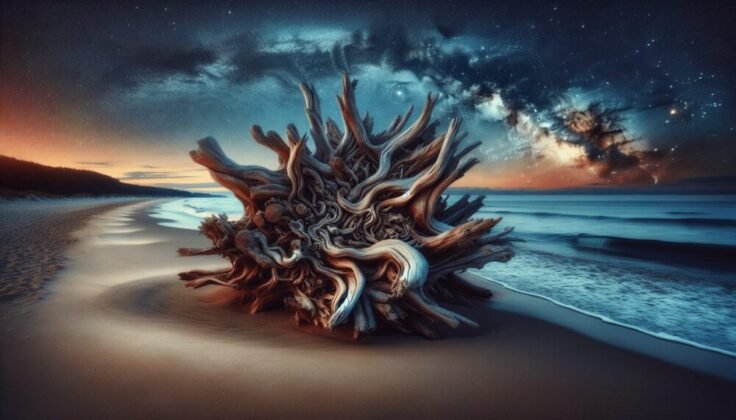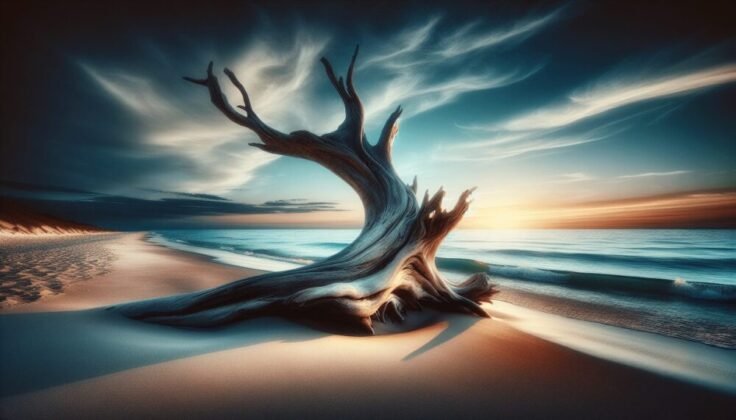Have you ever wandered along a stretch of beach and stumbled upon a colossal piece of driftwood? These massive, weathered logs are not just random debris but are often the result of a fascinating natural journey. Giant driftwood, in particular, has captured the imagination of nature enthusiasts, artists, and even scientists. If you’ve ever been curious about the life story of these enormous wooden wanderers, you’ve come to the right place.

The Basics of Driftwood
Before diving into the specifics of giant driftwood, it’s crucial to understand driftwood in general. Driftwood refers to any piece of wood that has been washed onto shore by the action of tides, winds, or waves. This wood can originate from trees, shrubs, and even from human activity such as construction.
What Makes Driftwood?
Driftwood starts its journey as part of a tree or other wooden structure. Trees along riverbanks or seacoasts can fall into the water due to erosion, storms, or human intervention. Once in the water, the wood is carried by currents, winds, and tides. Over time, it may travel hundreds or even thousands of miles before coming to rest on a distant shore.
Types of Driftwood
Not all driftwood is the same. There are various types, each shaped by its journey and the elements it has encountered.
| Type of Driftwood | Description |
|---|---|
| Freshwater Driftwood | Found in lakes and rivers, generally less weathered than saltwater driftwood. |
| Saltwater Driftwood | Originates from the ocean, often more eroded due to the abrasive marine environment. |
| Shoreline Driftwood | Comes from nearby shores and is usually less traveled and more identifiable as specific tree types. |
The Journey of Giant Driftwood
Giant driftwood is an extraordinary subset of the driftwood family. These extensive pieces of wood can measure several feet long and weigh hundreds of pounds. Understanding how they move from being part of a tree to giant driftwood can be truly astonishing.
Origin
The sheer size of giant driftwood suggests its origin in large trees, often from old-growth forests. These trees can be hundreds or even thousands of years old, towering high into the sky before they fall from erosion, windstorms, or logging. The process of becoming driftwood usually begins when these giant trees fall into a river or stream.
Transportation
Given their size, the journey of giant driftwood can be a slow and arduous one. The enormous weight means that they are often at the mercy of strong currents and high water levels to be moved from one place to another. These pieces of wood may travel through rivers, estuaries, and eventually out to sea, depending on their origin.
Transformation
As these large pieces of driftwood are transported, they undergo significant transformation. The constant interaction with water, salt, sun, and even marine life changes the wood’s structure. Holes may form, the surface may become eroded, and its overall shape can change dramatically.
Here’s a breakdown of how these factors impact giant driftwood:
| Factor | Impact on Driftwood |
|---|---|
| Water | Softens and erodes the wood, often leading to unique textures and patterns |
| Sun Exposure | Dries out the wood, leading to cracking and further weathering |
| Marine Life | Can bore into the wood, creating holes and tunnels |
| Wind and Waves | Continually batter the driftwood, rounding off edges and further sculpting its shape |
Ecological Significance
Giant driftwood isn’t just visually stunning; it plays a crucial role in various ecosystems.
Habitat Creation
These large pieces of driftwood provide essential habitats for numerous creatures. Birds use them for nesting, seals and other marine animals use them for resting spots, and various insects and marine organisms make their homes within the wood.
Shoreline Protection
Giant driftwood can help to protect shorelines from erosion. When they come to rest on a beach, they can act as natural barriers, slowing the process of erosion by breaking the force of waves.
Nutrient Cycling
As giant driftwood breaks down, it contributes essential nutrients to the surrounding ecosystem. This process supports the growth of other plants and the overall health of the habitat.
Human Interaction with Giant Driftwood
Beyond its ecological importance, giant driftwood has captivated human culture in various ways.
Art and Craft
Artists and craftspeople often use giant driftwood due to its unique shapes and textures. From large sculptures to intricate carvings, the wood serves as a medium for creative expression.
Furniture and Decor
Giant driftwood pieces are also popular in interior design. They can be crafted into tables, chairs, and other pieces of furniture that bring a rustic, natural aesthetic to any space. Often, these items are prized for their organic beauty and uniqueness.
Cultural Significance
In many coastal cultures, giant driftwood holds significant cultural value. For some indigenous communities, these large wooden pieces are considered sacred and used in rituals and ceremonies.

Conservation and Ethical Considerations
While giant driftwood can be stunning and useful, there are conservation and ethical considerations to keep in mind.
Legal Regulations
In some areas, it is illegal to remove driftwood from beaches due to its ecological importance. Always check local regulations before collecting driftwood.
Ethical Collection
Even if it is legal to collect driftwood, doing so ethically is crucial. Avoid removing pieces that serve as habitats for wildlife or play a critical role in shoreline stabilization.
Sustainable Use
If you’re using driftwood for art or decor, consider sourcing it from places where it has already been removed or from suppliers that sustainably harvest it.
How to Identify Giant Driftwood
Identifying giant driftwood involves understanding certain characteristics. Because these pieces are highly weathered, identification to a specific tree species might be difficult. However, some general traits can help.
Visual Cues
Look for large sizes, unique shapes, and eroded textures. The wood often exhibits a gray or silver patina due to prolonged exposure to the elements.
Physical Characteristics
Touch the wood. It should feel smooth and weathered, often with deep grooves or holes. The wood may also be lighter than its size suggests due to the erosion and drying process.
Location Clues
Giant driftwood found near old-growth forests or regions known for large tree species can give you clues about its origin.
Caring for Collected Driftwood
If you’ve collected or acquired a piece of giant driftwood, you may wonder how to care for it to ensure it lasts a long time.
Cleaning
Clean the driftwood thoroughly. Soak it in fresh water for several days to remove salts, then scrub it to remove any algae or debris.
Drying
Allow the driftwood to dry completely. This can take several weeks, depending on its size and the environmental conditions.
Preservation
To preserve the wood, consider applying a sealant or varnish. This will protect it from further weathering and help it maintain its beauty.
Stories and Legends
Giant driftwood has inspired numerous stories and legends. From tales of shipwrecks to mythical sea creatures, these large pieces of wood often spark the imagination.
Folklore
In some cultures, giant driftwood is believed to be imbued with spirits or to possess magical properties. These stories often add a layer of mystique to these natural wonders.
Modern Tales
Even today, people are fascinated by the journey of giant driftwood. Documentaries, books, and articles frequently explore the enigmatic lives of these wooden travelers.
Conclusion
Giant driftwood is more than just a piece of wood washed ashore. It is a testament to the forces of nature, a crucial component of ecosystems, and a source of inspiration for human creativity.
Whether you’re an artist, a nature enthusiast, or simply someone who loves a good story, the world of giant driftwood offers endless fascination.